History
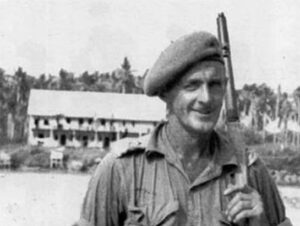 Soldiers everywhere have varied backgrounds, but maybe more so during World War I and World War II, as well as wars in which there was a draft. Robert Kerr “Jock” McLaren was a veterinarian by trade, but during his service with the Second Australian Imperial Force, he also became a feared guerrilla fighter who ran missions against the Japanese. I suppose that, while a veterinarian doesn’t work on humans, possessing certain skills would be important in certain situations. McLaren spent countless hours, days, and weeks in the jungles, and after one such assignment, his medical skills suddenly became urgently needed…on himself. McLaren found himself faced with surgery on himself, or certain death. So, in order to save his own life, McLaren set about to remove his own appendix…in the jungle, with a pen knife, two spoons, and coconut fibers.
Soldiers everywhere have varied backgrounds, but maybe more so during World War I and World War II, as well as wars in which there was a draft. Robert Kerr “Jock” McLaren was a veterinarian by trade, but during his service with the Second Australian Imperial Force, he also became a feared guerrilla fighter who ran missions against the Japanese. I suppose that, while a veterinarian doesn’t work on humans, possessing certain skills would be important in certain situations. McLaren spent countless hours, days, and weeks in the jungles, and after one such assignment, his medical skills suddenly became urgently needed…on himself. McLaren found himself faced with surgery on himself, or certain death. So, in order to save his own life, McLaren set about to remove his own appendix…in the jungle, with a pen knife, two spoons, and coconut fibers.
McLaren was just a teenager during World War I, when he served with the 51st (Highland) Division of the British Army. Because he was so young then, it’s unlikely that he saw combat on the Western Front. Nevertheless, his name is found on the rolls from his division’s time in France in 1918. That made people wonder if he participated in fighting during the Spring Offensive. Following the war, McLaren returned to 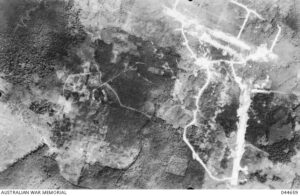 Scotland and completed training to become a veterinarian. He then moved to Queensland, Australia, where he worked as a veterinary officer in Bundaberg.
Scotland and completed training to become a veterinarian. He then moved to Queensland, Australia, where he worked as a veterinary officer in Bundaberg.
When World War II began, McLaren volunteered for the Second Australian Imperial Force. McLaren, 39 years old at the time, was assigned to the 2/10th Australian Field Workshops, 8th Australian Division and stationed in Singapore. McLaren spent time in a POW camp and escaped along with two other soldiers. After being tortured and faced with a firing squad, the trio were ultimately returned to their cells. McLaren, along with 1,000 British and Australian soldiers, was later transferred to Borneo and held at the Sandakan camp. He made plans to escape again, this time with a Chinese POW named Johnny Funk. The escape took the men to the large Philippine Island of Mindanao, where they joined the resistance led by American Reserve Officer, Lt. Col. Wendell Fertig. He was later given the chance to return to Australia, but chose to remain a guerrilla.
It was during his time as a guerrilla that McLaren’s appendicitis attack occurred. During one patrol as a 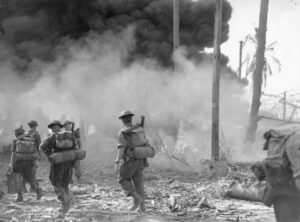 guerrilla, McLaren developed a severe case of appendicitis. He knew enough to know that he was going to have to treat himself, or he would die. So, he performed surgery with just a penknife and two spoons. He stitched the incision with coconut fibers. When asked about the act years later, he said, “It was hell, but I came through alright.” A modest remark for such a remarkable act…in the middle of a Philippine jungle in 1944, without any anesthetic and with only the use of a mirror to see. The operation took 4½ hours. Still, as he said he came through it alright, and he would not be that last person to do surgery on themselves. Nevertheless…remarkable.
guerrilla, McLaren developed a severe case of appendicitis. He knew enough to know that he was going to have to treat himself, or he would die. So, he performed surgery with just a penknife and two spoons. He stitched the incision with coconut fibers. When asked about the act years later, he said, “It was hell, but I came through alright.” A modest remark for such a remarkable act…in the middle of a Philippine jungle in 1944, without any anesthetic and with only the use of a mirror to see. The operation took 4½ hours. Still, as he said he came through it alright, and he would not be that last person to do surgery on themselves. Nevertheless…remarkable.
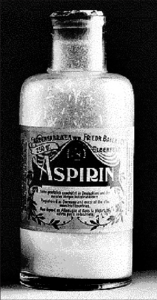
 Who hasn’t heard of Bayer Aspirin, or at the very least, aspirin? It has been a staple in households for as many as 124 years…until the Tylenol push, which in my opinion is the least effective pain medication of all time!!! Aspirin was developed from acetylsalicylic acid, which can be found in the bark of willow trees. Of course, it didn’t originate there. In its most primitive form, the active ingredient, Salicin was used for centuries in folk medicine, beginning in ancient Greece when Hippocrates used it to relieve pain and fever. I guess “modern medicine” hasn’t progressed so far after all. The Bayer version of aspirin was developed in Germany and patented on March 6, 1899. Even then, its unpleasant taste and tendency to damage the stomach, caused its sparing use. In the most modern adaptation of aspirin, the Bayer version, Bayer employee Felix Hoffmann found a way to create a stable form of the drug that was easier and more pleasant to take. Some evidence shows that Hoffmann’s work was really done by a Jewish chemist, Arthur Eichengrun, whose contributions were covered up during the Nazi era. After obtaining the patent rights, Bayer began distributing aspirin in powder form to physicians to give to their patients one gram at a time. The brand name came from “A” for acetyl, “spir” from the spirea plant, which was a source of salicin, and the suffix “in,” commonly used for medications. It quickly became the number-one drug worldwide.
Who hasn’t heard of Bayer Aspirin, or at the very least, aspirin? It has been a staple in households for as many as 124 years…until the Tylenol push, which in my opinion is the least effective pain medication of all time!!! Aspirin was developed from acetylsalicylic acid, which can be found in the bark of willow trees. Of course, it didn’t originate there. In its most primitive form, the active ingredient, Salicin was used for centuries in folk medicine, beginning in ancient Greece when Hippocrates used it to relieve pain and fever. I guess “modern medicine” hasn’t progressed so far after all. The Bayer version of aspirin was developed in Germany and patented on March 6, 1899. Even then, its unpleasant taste and tendency to damage the stomach, caused its sparing use. In the most modern adaptation of aspirin, the Bayer version, Bayer employee Felix Hoffmann found a way to create a stable form of the drug that was easier and more pleasant to take. Some evidence shows that Hoffmann’s work was really done by a Jewish chemist, Arthur Eichengrun, whose contributions were covered up during the Nazi era. After obtaining the patent rights, Bayer began distributing aspirin in powder form to physicians to give to their patients one gram at a time. The brand name came from “A” for acetyl, “spir” from the spirea plant, which was a source of salicin, and the suffix “in,” commonly used for medications. It quickly became the number-one drug worldwide.
In the beginning, like most drugs, Aspirin was a prescription-only drug, but in 1915, Aspirin was made available in tablet form and without a prescription. In 1917, when Bayer’s patent expired during the First World War, the Bayer company lost the trademark rights to aspirin in various countries. After the United States entered the war against Germany in April 1917, the Alien Property Custodian, a government agency that administers foreign property, seized Bayer’s US assets. Two years later, the Bayer company name and trademarks for the United States and Canada were auctioned off and purchased by Sterling Products Company, later Sterling Winthrop, for $5.3 million. 

As companies do, with mergers and splits, Bayer became part of IG Farben, the conglomerate of German chemical industries that formed the financial heart of the Nazi regime. Then after the Nazi defeat in World War II, the Allies split apart IG Farben, and Bayer again emerged as an individual company. With its purchase of Miles Laboratories in 1978, came a product line including Alka-Seltzer and Flintstones and One-A-Day Vitamins. Then in 1994, coming full circle, Bayer bought Sterling Winthrop’s over-the-counter business, which allowed it to gain back the rights to the Bayer name and logo, and after almost 100 years, and the company once again was allowed to profit from American sales of its most famous product.
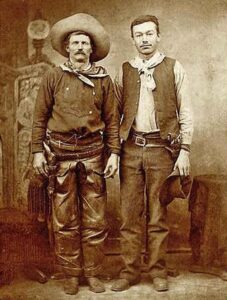
 When we think of a cowboy, we usually picture the American Cowboy, rough and rugged wearing a cowboy hat, a gun on his hip, and riding he favorite horse around the Old West. One thing we wouldn’t think of is that we really wouldn’t think of an American Cowboy being born in Canada. Nevertheless, one of the most “unusual” American Cowboys was actually born in Canada. His name was Charles Nebo, or as he was known by nickname, Charley, and he was born in March of 1842. Charles Nebo wasn’t your typical cowboy and might have even been more Forrest Gump than soldier, although he wasn’t autistic, like Forrest Gump was…or at least, not that anyone knew of.
When we think of a cowboy, we usually picture the American Cowboy, rough and rugged wearing a cowboy hat, a gun on his hip, and riding he favorite horse around the Old West. One thing we wouldn’t think of is that we really wouldn’t think of an American Cowboy being born in Canada. Nevertheless, one of the most “unusual” American Cowboys was actually born in Canada. His name was Charles Nebo, or as he was known by nickname, Charley, and he was born in March of 1842. Charles Nebo wasn’t your typical cowboy and might have even been more Forrest Gump than soldier, although he wasn’t autistic, like Forrest Gump was…or at least, not that anyone knew of.
Charlie never tried to inflate his achievements and was happy to live like a true frontier man, nevertheless, people often made him sound like he was…maybe, a little bit more of a cowboy than he actually was. I suppose it made no sense to say that he was just a “good old boy” from out west. People don’t expect that, and maybe, they just wouldn’t read about it, either, but the reality is that there were more average people in the American West than there were the wild people who made the West famous.
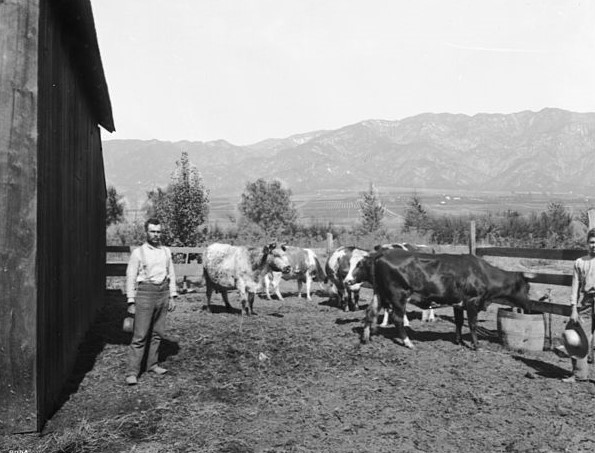
Charley Nebo lived in Canada until 1861. Then, he moved to Saginaw, Michigan. He was a Union soldier during the Civil War and went on to become a cowboy in New Mexico. At one point he actually befriended Billy the Kid. Nebo wrote about him in a letter, saying, “He wasn’t the ruthless bad fellow that Western history has made him out to be.” Nebo apparently gave people the benefit of the doubt, and himself, as a respected cowboy, once shot a man after witnessing him kill a Mexican boy’s dog. In all, Nebo was a common man, humble and capable. He wasn’t what people might call spectacular, but he was a good man, and it took a lot of those good men to build the American West.

 The Sinking Ship parking garage in Seattle is aptly named, a fact which you can clearly see when you look at it. The building is a multi-story parking garage in Pioneer Square and James Street to the north, Yesler Way to the south, and 2nd Avenue to the east. It is just steps away from the Pioneer Building on the site of the former Occidental Hotels and Seattle Hotel. The look of the structure gives the illusion of a sinking ship, even though it is level. After the Seattle Hotel was demolished in 1961, the Sinking Ship was built as part of a neighborhood redesign.
The Sinking Ship parking garage in Seattle is aptly named, a fact which you can clearly see when you look at it. The building is a multi-story parking garage in Pioneer Square and James Street to the north, Yesler Way to the south, and 2nd Avenue to the east. It is just steps away from the Pioneer Building on the site of the former Occidental Hotels and Seattle Hotel. The look of the structure gives the illusion of a sinking ship, even though it is level. After the Seattle Hotel was demolished in 1961, the Sinking Ship was built as part of a neighborhood redesign.
Designers Gilbert H Mandeville, an engineer and Gudmund B Berge, an architect of the Seattle firm Mandeville  and Berge built the structure in 1965. They also designed the Logan Building and an addition to the First Presbyterian Church downtown, the Ballard branch of Seattle Public Library, which is an unusual building too, although not like the Sinking Ship, and two buildings at the Seattle World’s Fair in 1962….the Alaska Building and the Transportation 21 Building, neither of which are really unusual.
and Berge built the structure in 1965. They also designed the Logan Building and an addition to the First Presbyterian Church downtown, the Ballard branch of Seattle Public Library, which is an unusual building too, although not like the Sinking Ship, and two buildings at the Seattle World’s Fair in 1962….the Alaska Building and the Transportation 21 Building, neither of which are really unusual.
The parking It is owned by the Kubota–Fujii family, who had acquired the Seattle Hotel in 1941. Doris Kubota, from the same family, called the garage the “ugliest building in all of Seattle.” During the 2001 Mardi Gras riot the building was used as a staging area for police and city officials. The Seattle Monorail Project had hoped to acquire the site through condemnation to turn it into a monorail station at the site of the Sinking Ship, but the Kubota family disputed the condemnation lawsuit, stating their intention to build housing and retail at the site.

 While Doris Kubota thought the building was ugly, it was named the “coolest parking lot” in the United States by the design publication Architizer Journal in 2019 and still remains on that list today, dropping to 4th place. While I agree that it is cool, I’m not a fan of concrete buildings. Still, it makes sense for a parking structure to be made out of concrete. As of 2022, the garage is managed by Diamond Parking, and it is open 24 hours a day.
While Doris Kubota thought the building was ugly, it was named the “coolest parking lot” in the United States by the design publication Architizer Journal in 2019 and still remains on that list today, dropping to 4th place. While I agree that it is cool, I’m not a fan of concrete buildings. Still, it makes sense for a parking structure to be made out of concrete. As of 2022, the garage is managed by Diamond Parking, and it is open 24 hours a day.

 Many people think that the Leaning Tower of Pisa was once straight, and then gradually began to lean, but that is not the case at all. Nevertheless, the lean became problematic over time. Construction on the Leaning Tower began on August 9, 1173. The plan was for the tower to house the bells of the vast cathedral of the Piazza dei Miracoli, which means the “Place of Miracles” in English. The city of Pisa at that time was a major trading power and one of the richest cities in the world. The bell tower was designed to be the most magnificent tower Europe had ever seen. Work progressed…until the tower was just over three stories tall, and then it abruptly stopped for reasons unknown. There has been speculation as to why the construction was stopped. Some people think it may have been because of economic or political strife, but the consensus seems to be that the engineers may have noticed that even then, the tower had begun to sink down into the ground on one side.
Many people think that the Leaning Tower of Pisa was once straight, and then gradually began to lean, but that is not the case at all. Nevertheless, the lean became problematic over time. Construction on the Leaning Tower began on August 9, 1173. The plan was for the tower to house the bells of the vast cathedral of the Piazza dei Miracoli, which means the “Place of Miracles” in English. The city of Pisa at that time was a major trading power and one of the richest cities in the world. The bell tower was designed to be the most magnificent tower Europe had ever seen. Work progressed…until the tower was just over three stories tall, and then it abruptly stopped for reasons unknown. There has been speculation as to why the construction was stopped. Some people think it may have been because of economic or political strife, but the consensus seems to be that the engineers may have noticed that even then, the tower had begun to sink down into the ground on one side.
The tower sat unfinished for 95 years, which allowed the building to settle, and the new chief engineer tried to figure out a way to compensate for the tower’s visible lean by making the new stories slightly taller on the short side. In theory, that may have seemed like a viable solution, but when you add weight without addressing the problem that is causing the building to sink, you are fighting against yourself. By 1278, when the workers had reached the top of the seventh story, they were forced to stop construction again, because they realized that the southward tilt was now nearly three feet…even with the adjustments they had tried to make to compensate.
The frustrated Italian government, rather at its wits end, announced on February 27, 1964, that it would be accepting suggestions on how to save the renowned Leaning Tower of Pisa from collapse. By this time, the top of the 180-foot tower was hanging an astonishing 17 feet south of the base, and to make matters worse, studies showed that the tilt was increasing by a fraction every year. That may not seem like so much, but like the “straw that broke the camel’s back,” no one knew Exactly when the point would come when the tower could not be saved. That also meant that the tower was unsafe to allow people to come in, or at least it was perceived to be eminently unsafe, and when the experts warned that the medieval building…one of Italy’s top tourist attractions, was in serious danger of collapse in an earthquake or storm, something had to be done.
The Italian government began to reach out in earnest for proposals to save the Leaning Tower, and proposals came from all over the world, but it was not until 1999 that successful restorative work began. In recent years, the cause of the lean was finally determined to be that the tower’s lean was caused by the remains of an ancient river estuary located under the building. That information told them that a completely safe resolution was unlikely, and that straightening the tower was completely out of reach in its current location.
In 1990, the Italian government closed the Leaning Tower’s doors to the public out of safety concerns and began considering more drastic proposals to save the tower. Then, in 1992, in an effort to temporarily stabilize the building, plastic-coated steel tendons were built around the tower up to the second story. In 1993, a concrete foundation was built around the tower, adding counterweights on the north side. The use of these weights lessened the tilt by nearly an inch, bringing new hope to the people. Still, it was an eyesore, and in 1995, the commission overseeing the restoration sought to replace the unsightly counterweights with underground cables. The strange method to do this was that engineers froze the ground with liquid nitrogen in preparation for the removal of the counterweights. Unfortunately, this actually caused a dramatic increase in the lean and the project was called off. Finally, in 1999, engineers began a process of soil extraction under the north side that within a few months was showing positive effects. The soil was removed at a very slow pace, no more than a gallon or two a day, and a massive cable harness held the tower to avoid any sudden destabilization. Finally, it seemed that progress was being made. Within six months, the tilt had been reduced 
 by over an inch, and by the end of 2000, nearly a foot. Relieved, the Italian government was able to reopen the tower to the public in December 2001, after a foot-and-a-half reduction had been achieved. While this will not stop the continuing tilt, it is expected that those 18 inches will give another 300 years of life to the Leaning Tower of Pisa…an amazing feat indeed. The tower will have to be carefully monitored to ensure the safety of those who visit it every year, but for now, disaster has been averted.
by over an inch, and by the end of 2000, nearly a foot. Relieved, the Italian government was able to reopen the tower to the public in December 2001, after a foot-and-a-half reduction had been achieved. While this will not stop the continuing tilt, it is expected that those 18 inches will give another 300 years of life to the Leaning Tower of Pisa…an amazing feat indeed. The tower will have to be carefully monitored to ensure the safety of those who visit it every year, but for now, disaster has been averted.
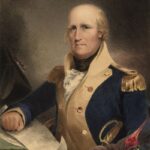
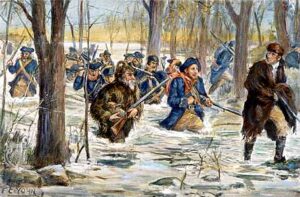 The British tried very hard to keep the United States colonies of Great Britain. The odds were in their favor, but they badly misjudged the determination of the early pioneers of this country. The Revolutionary War would bear that out. On February 5, 1779, George Rogers Clark departed Kaskaskia on the Mississippi River with a force of approximately 170 men, including Kentucky militia and French volunteers. Their goal was to take Fort Sackville (Fort Vincennes, at that time), British garrison under Lieutenant-Governor Henry Hamilton. The men traveled across what is now the state of Illinois, a journey of about 180 miles, much of it covered by deep and icy flood water until they reached Fort Sackville at Vincennes, in what is now Indiana. They reached the Embarras River on February 17th, placing them only 9 miles from Fort Sackville. Unfortunately, the river was too high to cross there, so they followed the Embarrass River down to the Wabash River, where the next day they began to build boats. Moral was low, because they had been without food for the last two days, and Clark struggled to keep his men from deserting. Clark later wrote that “I conducted myself in such a manner that caused the whole to believe that I had no doubt of success, which kept their spirits up.” He really had no choice, no matter what his true feelings were on the matter. Still, in a February 20 entry in Captain Bowman’s Field Journal, he describes the men in camp as “very quiet but hungry; some almost in despair; many of the creole volunteers talking of returning.” The situation grew more bleak by the day, and on February 22, Bowman reports that they still have “No provisions yet. Lord, help us!” and that “Those that were weak and famished from so much fatigue went in the canoes” as they marched towards toward Vincennes.
The British tried very hard to keep the United States colonies of Great Britain. The odds were in their favor, but they badly misjudged the determination of the early pioneers of this country. The Revolutionary War would bear that out. On February 5, 1779, George Rogers Clark departed Kaskaskia on the Mississippi River with a force of approximately 170 men, including Kentucky militia and French volunteers. Their goal was to take Fort Sackville (Fort Vincennes, at that time), British garrison under Lieutenant-Governor Henry Hamilton. The men traveled across what is now the state of Illinois, a journey of about 180 miles, much of it covered by deep and icy flood water until they reached Fort Sackville at Vincennes, in what is now Indiana. They reached the Embarras River on February 17th, placing them only 9 miles from Fort Sackville. Unfortunately, the river was too high to cross there, so they followed the Embarrass River down to the Wabash River, where the next day they began to build boats. Moral was low, because they had been without food for the last two days, and Clark struggled to keep his men from deserting. Clark later wrote that “I conducted myself in such a manner that caused the whole to believe that I had no doubt of success, which kept their spirits up.” He really had no choice, no matter what his true feelings were on the matter. Still, in a February 20 entry in Captain Bowman’s Field Journal, he describes the men in camp as “very quiet but hungry; some almost in despair; many of the creole volunteers talking of returning.” The situation grew more bleak by the day, and on February 22, Bowman reports that they still have “No provisions yet. Lord, help us!” and that “Those that were weak and famished from so much fatigue went in the canoes” as they marched towards toward Vincennes.
Their first real break came on February 20th, when they captured five hunters from Vincennes, who were traveling by boat. In their complete surprise, they revealed that Clark and his little army had not yet been detected. They also revealed that the people of Vincennes were sympathetic to the Americans, and not the British. The news served to revive the men, and the next day, they crossed the Wabash by canoe, leaving their packhorses behind. On foot, they marched towards Vincennes. It was still not an easy go of it, and sometimes the men found themselves in water up to their shoulders. A 4-mile-wide flooded plain made the last few days the hardest, and they were forced to use the canoes to shuttle the most weary and weakened men from high point to high point. Shortly before reaching Vincennes, they encountered a villager known to be a friend, who informed Clark that they were still unsuspected. Clark sent the man ahead with a letter to the inhabitants of Vincennes, warning them that he was just about to arrive with an army and that everyone should stay in their homes unless they wanted to be considered an enemy. The message was read in the public square, and no one went to the fort to warn Hamilton. Clark secured the surrender of the British garrison at 10am on February 25, 1779, after brutally killing five captive Native Americans who were British alleys, within view of the fort, probably to scare those inside.
Prior to the surrender of Fort Sackville, the British truly thought that they were on track to win this war and retain their control, but the surrender of Fort Sackville took the wind out of their sails, and literally marked the beginning of the end of British domination in America’s western frontier. There were only 40 British soldiers in Fort Sackville, and an equal number of mixed French volunteers and French settlers who fought on both sides of the American Revolution. The French portion of Hamilton’s force was reluctant to fight once they realized their compatriots had allied themselves with Clark. To further confuse those in the fort, Clark managed to make his 170 men seem more like 500 by unfurling flags suitable to a larger number of troops. The able woodsmen filling Clark’s ranks were able to fire at a rapid rate. That caused Hamilton to believe that he was surrounded by a substantial army. While Hamilton was occupied, Clark began tunneling under the fort planning to explode the gunpowder stores within it.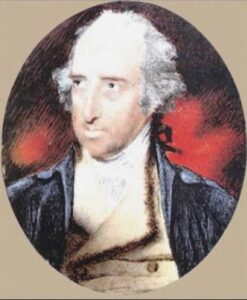
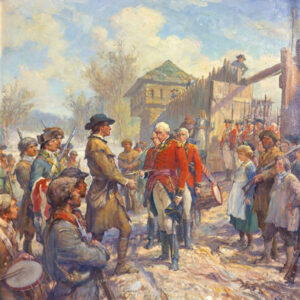
When a Native American raiding party attempted to return to the fort from the Ohio Valley, Clark’s men killed or captured all of them. The public tomahawk executions served upon five of the captives frightened the British, assuming that theirs might be a similar fate in Clark’s hands. When the British surrendered to Clark’s men, the Native Americans understood fully that they could no longer rely on the British to protect them from the Patriots. The British finally understood too, that they were no match for the determined patriots. The United States was finally free of the British.

 For people who live in Casper, Wyoming, the mountain to the south has long been a great recreation area. They are campgrounds and a ski resort, not to mention the trails that dot the mountain top. While the mountain is mostly recreational today, along with a number of people who live on the mountain full-time, that wasn’t always the case. In 1890, a gold strike on Casper Mountain brought a little gold rush to the area…along with many different kinds of people, looking to strike it rich. The mountain was crawling with people from all walks of life, but while they looked until 1895, they didn’t find much gold. The materials found were mostly asbestos and other non-profitable minerals.
For people who live in Casper, Wyoming, the mountain to the south has long been a great recreation area. They are campgrounds and a ski resort, not to mention the trails that dot the mountain top. While the mountain is mostly recreational today, along with a number of people who live on the mountain full-time, that wasn’t always the case. In 1890, a gold strike on Casper Mountain brought a little gold rush to the area…along with many different kinds of people, looking to strike it rich. The mountain was crawling with people from all walks of life, but while they looked until 1895, they didn’t find much gold. The materials found were mostly asbestos and other non-profitable minerals.
Nevertheless, there arose a need for a town and supply stores, so the town of Eadsville was formed. It was located 12 miles due south of Casper on top of Casper Mountain. It was founded by Charles W Eads in 1891 after he had staked a 600-foot x 1,500-foot mining claim around a large spring. The town was named for one Charles W Eads, who was the second person to settle in Casper, following a Mr. Merritt, who was credited with being the first to locate to Casper. Eads appeared in the Natrona County Tribune, May 13, 1908, and was apparently accused of being a horse thief. He would go on to do time in prison.
It was thought that there were large deposits of precious minerals, such as gold, silver, lead, and copper. The town continued to develop, with lots being sold in the town during 1891 – 1892. During that time, about a dozen cabins were built. While the town became a ghost town before very long, the foundations of three cabins still remain today. During the boom years, some 40 to 50 people lived there, all hoping to make their millions in gold and silver. Some traces of gold and silver were found, and copper was also mined, but asbestos and feldspar were the most economical to mined. The “spar” was still being mined after nearly 100 years. It’s no longer being mined, but it could be again, if there was a need.
After a time of trying unsuccessfully to make a living, the miners finally gave up and abandoned the town 
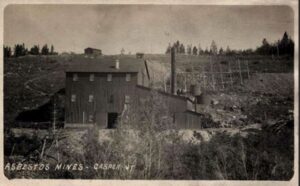 between 1905 and 1906. The site was rediscovered in the 1980s, and numerous artifacts were uncovered during an archeological excavation that was conducted between 1983 and 1985. At one time it was surveyed as a stamp mill. Eadsville was located on Casper Mountain at an elevation of 7,800 feet and covered an area 20 acres.
between 1905 and 1906. The site was rediscovered in the 1980s, and numerous artifacts were uncovered during an archeological excavation that was conducted between 1983 and 1985. At one time it was surveyed as a stamp mill. Eadsville was located on Casper Mountain at an elevation of 7,800 feet and covered an area 20 acres.

 I think that we can all say that we have found ourselves on the wrong side of history…at the very least our belief system. That is really where most of the world found themselves when Adolf Hitler was elected to office, and almost immediately began to pour out his evil plan for the world, and his hatred for anyone not Aryan, which in Nazi ideology, “denotes white non-Jewish people, especially those of northern European origin or descent typically having blond hair and blue eyes and regarded as a supposedly superior racial group.” Hitler had so deceived the world, in fact, that just a short six and a half months before Hitler invaded Poland, New York City’s Madison Square Garden hosted a rally to celebrate the rise of Nazism in Germany!! More than 20,000 people were in attendance. They raised Nazi salutes toward a 30-foot-tall portrait of George Washington flanked by swastikas. Of course, not everyone was fooled by Hitler, and in fact the 20,000 were a very small percentage, but these 20,000 were, whether they ever understood it or not, on the wrong side of history, trying to follow a man who was insanely evil, murderous, and racist. Outside, police and some 100,000 protestors, who saw right through Hitler’s beliefs, gathered.
I think that we can all say that we have found ourselves on the wrong side of history…at the very least our belief system. That is really where most of the world found themselves when Adolf Hitler was elected to office, and almost immediately began to pour out his evil plan for the world, and his hatred for anyone not Aryan, which in Nazi ideology, “denotes white non-Jewish people, especially those of northern European origin or descent typically having blond hair and blue eyes and regarded as a supposedly superior racial group.” Hitler had so deceived the world, in fact, that just a short six and a half months before Hitler invaded Poland, New York City’s Madison Square Garden hosted a rally to celebrate the rise of Nazism in Germany!! More than 20,000 people were in attendance. They raised Nazi salutes toward a 30-foot-tall portrait of George Washington flanked by swastikas. Of course, not everyone was fooled by Hitler, and in fact the 20,000 were a very small percentage, but these 20,000 were, whether they ever understood it or not, on the wrong side of history, trying to follow a man who was insanely evil, murderous, and racist. Outside, police and some 100,000 protestors, who saw right through Hitler’s beliefs, gathered.
The organization who was behind the February 20, 1939 event, was the German American Bund (“Bund” is German for “federation”), had advertised the event as a “Pro American Rally.” The antisemitic organization held Nazi summer camps for youth and their families during the 1930s. Doesn’t that sound a lot like Hitler’s Youth Camps, that later turned into just the Hitler Youth, where he forcefully took children from their parents saying that the parents were ill-equipped to properly raise their children. Then, he turned those youth into killing machines, with no regard for human life. The Bund’s youth members were present at the February 20th rally, as were the Ordnungsdienst, or OD, the group’s vigilante police force who dressed in the style of Hitler’s SS officers. In Germany, these were the Jewish Ghetto Police or Jewish Police Service (German: Jüdische, Ghetto-Polizei, or Jüdischer Ordnungsdienst), also called the Jewish Police by Jews, and they were auxiliary police units organized within the Nazi ghettos by local Judenrat (Jewish councils). Their “job” was to keep order, or rather monitor the orderly persecution and murder of the Jewish people.
At the rally, there were banners hanging with messages like “Stop Jewish Domination of Christian Americans” and “Wake Up America. Smash Jewish Communism.” When the Bund’s national leader, Fritz Kuhn, gave his closing speech, he referred to President Franklin Delano Roosevelt as “Rosenfield” and Manhattan District Attorney Thomas Dewey as “Thomas Jewey.” Kuhn, a naturalized American who lost his citizenship during World War II, declared, “We, with American ideals, demand that our government shall be returned to the American people who founded it. If you ask what we are actively fighting for under our charter: First, a socially just, white, Gentile-ruled United States. Second, Gentile-controlled labor unions, free from Jewish Moscow-directed domination.” Isadore Greenbaum, a brave Jewish-American man, interrupted Kuhn’s speech by charging the stage in protest. Undaunted, the police and the vigilante force quickly tackled him and proceeded to beat him up on stage. The crowd cheered as they threw him off stage, pulling his pants down in the process. Police charged Greenbaum with disorderly conduct and gave him a $25 fine, which today would have equaled about $450. They were not only intent on inflicting pain, but also humiliation. They are people who have stepped into the insane world of evil. Definitely the wrong side of history.
At the time the rally took place, Hitler was completing his sixth concentration camp. The protesters, many of them Jewish Americans, were trying to call attention to what was happening in Germany, saying that it could happen in the United States. Their fliers proclaimed, “Don’t wait for the concentration camps—Act now!” Outside the rally, people carried signs with messages like “Smash Anti-Semitism” and “Give me a gas mask, I can’t stand the smell of Nazis.” The police responded to the protesters with violent attacks. The night was riddled with violence. One protester escaped a mounted police officer, by punching his horse in the face. As the rally broke up, some protesters slipped by the police to punch departing Nazis in the face.

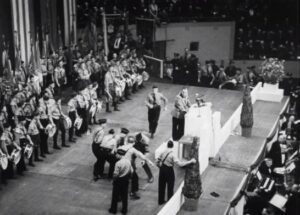 Looking back on how the Nazi history played out, and especially the atrocities of Hitler, I wonder if the people who were at the rally in support of Hitler felt about their…hero now. I suppose that being obsessed with evil, they might have been fine with the Holocaust, and all of the killing that took place. All we can hope is that maybe at least a few of then saw the error of their ways, and realized just how evil Hitler and the Third Reich really were.
Looking back on how the Nazi history played out, and especially the atrocities of Hitler, I wonder if the people who were at the rally in support of Hitler felt about their…hero now. I suppose that being obsessed with evil, they might have been fine with the Holocaust, and all of the killing that took place. All we can hope is that maybe at least a few of then saw the error of their ways, and realized just how evil Hitler and the Third Reich really were.
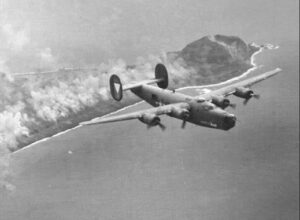
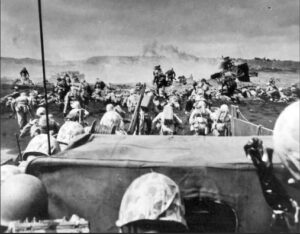 The taking of vital ground is an important, if not essential part of war. In World War II, Iwo Jima was vital ground. It was prime real estate on which to build airfields to launch bombing raids against Japan, just 660 miles away. The Japanese had it, and the Americans needed it. So, they devised a plan to evict the, then current occupiers, so they could have it. The planned attack was called Operation Detachment, and the plan was to invade Iwo Jima thus putting the Allies in a better position to attack Japan.
The taking of vital ground is an important, if not essential part of war. In World War II, Iwo Jima was vital ground. It was prime real estate on which to build airfields to launch bombing raids against Japan, just 660 miles away. The Japanese had it, and the Americans needed it. So, they devised a plan to evict the, then current occupiers, so they could have it. The planned attack was called Operation Detachment, and the plan was to invade Iwo Jima thus putting the Allies in a better position to attack Japan.
The problem was that Iwo Jima was well fortified, both above and below ground…with a force that was 21,000 strong. The US Marines had to find out where the Japanese strongholds were on the island, so the invasion would take place is several phases. The United States had to be patient in the days leading up to the actual invasion, but they also had to apply pressure to keep the Japanese off guard.
To apply pressure, the Americans began bomber raids using B-24 and B-25 bombers in June 1944. The raids continued for 74 days. It was the longest pre-invasion bombardment of the war. Anytime bombing continues for that long, it has to be stressful for those in the bomb zone. The constant threat of falling bombs, and never knowing if they will land on you next, would make every day stressful. The bombing was necessary because of the extent to which the Japanese fortification of the island, above and below ground, including a network of caves.
Next came the Frogmen phase. “Frogmen” or Underwater Demolition Teams were dispatched by the Americans just before the actual invasion. The plan was to for the frogmen to draw fire from the Japanese, thus giving away many of their “secret” gun positions. Of course, as you can imagine, this was basically a suicide mission for the Underwater Demolition Teams. The amphibious landings of Marines began the morning of February 19, 1945, as the secretary of the navy, James Forrestal, accompanied by journalists, surveyed the scene from a command ship offshore. As the Marines made their way onto the island, seven Japanese battalions opened fire on them. By evening, more than 550 Marines were dead and more than 1,800 were wounded. It took four more days and many more casualties to capture of Mount Suribachi, the highest point of the island and bastion of the Japanese defense. While the taking of Iwo Jima was vital and those who fought and died there willingly gave 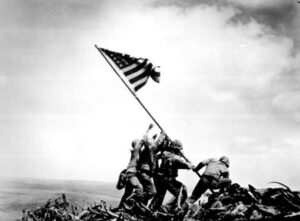
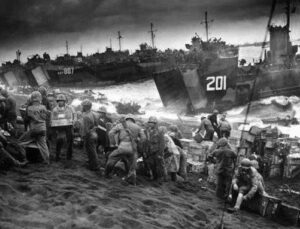 their lives for it, I have to think that it was a bittersweet victory, because of so many lives lost. Much like the D-Day storming of the beaches of Normandy, Iwo Jima was a suicide mission that was vital to the outcome of the war. The photo of the raising of the American flag on Iwo Jima, won the Pulitzer Prize for the photographer who took it, but I’m sure it was a photograph he would rather not have taken, considering the loss of life.
their lives for it, I have to think that it was a bittersweet victory, because of so many lives lost. Much like the D-Day storming of the beaches of Normandy, Iwo Jima was a suicide mission that was vital to the outcome of the war. The photo of the raising of the American flag on Iwo Jima, won the Pulitzer Prize for the photographer who took it, but I’m sure it was a photograph he would rather not have taken, considering the loss of life.

 On October 31, 1922, following the March on Rome, Benito Mussolini was appointed prime minister by King Victor Emmanuel III. With that appointment, he became the youngest individual to hold the office up to that time. Mussolini quickly got to work, removing all political opposition through his secret police and outlawing labor strikes. He, along with his followers consolidated power through a series of laws that transformed Italy into a one-party dictatorship. A short five years later, he had established dictatorial authority by both legal and illegal means and planned to create a totalitarian state.
On October 31, 1922, following the March on Rome, Benito Mussolini was appointed prime minister by King Victor Emmanuel III. With that appointment, he became the youngest individual to hold the office up to that time. Mussolini quickly got to work, removing all political opposition through his secret police and outlawing labor strikes. He, along with his followers consolidated power through a series of laws that transformed Italy into a one-party dictatorship. A short five years later, he had established dictatorial authority by both legal and illegal means and planned to create a totalitarian state.
Still, as often happens, the people, good government officials, and of course, God made it clear that both fascist Italy and its dictator Benito Mussolini’s days were numbered by July 1943. So, after the successful Allied invasion of Sicily, the Italian government’s Grand Council delivered Mussolini a vote of no confidence. Shortly after that, King Vittorio Emanuele III replaced Mussolini as prime minister, and immediately had him arrested.
When Adolf Hitler heard of Mussolini’s arrest, he was furious. Hitler considered Mussolini to be his most powerful European ally, and Hitler began to make plans to rescue Mussolini. He brought in SS Major Otto Skorzeny, who was considered “the most dangerous man in Europe,” for the rescue mission. The Germans had 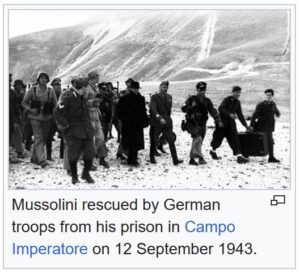 discovered that Mussolini was being held in a mountain ski resort 7,000 feet above sea level in the Abruzzo region. Due to the remoteness of the location, Skorzeny decided the only way to rescue Mussolini was to send in a dozen gliders with 108 commandos to do the job. The mission, dubbed Operation Eiche commenced on September 12, 1943. Along with the commandos, Skorzeny brought along an Italian general named Soleti. It was Soleti’s mission to create confusion among Mussolini’s guards, thereby giving the commandos time to get to Mussolini. While Soleti shouted orders at the confused guards, the commandos recaptured Mussolini without incident and flew him to a nearby Luftwaffe airfield, then to Hitler’s Wolf’s Lair headquarters in East Prussia.
discovered that Mussolini was being held in a mountain ski resort 7,000 feet above sea level in the Abruzzo region. Due to the remoteness of the location, Skorzeny decided the only way to rescue Mussolini was to send in a dozen gliders with 108 commandos to do the job. The mission, dubbed Operation Eiche commenced on September 12, 1943. Along with the commandos, Skorzeny brought along an Italian general named Soleti. It was Soleti’s mission to create confusion among Mussolini’s guards, thereby giving the commandos time to get to Mussolini. While Soleti shouted orders at the confused guards, the commandos recaptured Mussolini without incident and flew him to a nearby Luftwaffe airfield, then to Hitler’s Wolf’s Lair headquarters in East Prussia.
While Mussolini was free now, this would not be the victory Mussolini had hoped for. The Germans installed Mussolini as the head of a puppet regime called the Italian Socialist Republic in the town of Salo. The position wasn’t much more than symbolic. The German press portrayed the rescue as a daring feat of bravery…at the time, but in 2016, Italian author Vincenzo Di Michele researched the raid and concluded that it was likely enabled by Mussolini sympathizers in the Italian government. Mussolini could not be allowed to be free, even to run a puppet regime, and so the Allies began their hunt for him. On April 25, 1945, Allied troops were advancing into northern Italy, and the collapse of the Salò Republic was imminent. Mussolini and his mistress Clara Petacci attempted to escape to Switzerland, intending to board a plane and escape to Spain. Two days later on April 27th, they were stopped near the village of Dongo (Lake Como) by communist partisans named 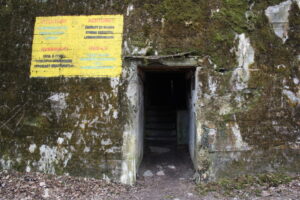
 Valerio and Bellini and identified by the Political Commissar of the partisans’ 52nd Garibaldi Brigade, Urbano Lazzaro. The next day, Mussolini and Petacci were both executed, along with most of the members of their 15-man train, primarily ministers and officials of the Italian Social Republic, in the small village of Giulino di Mezzegra by a partisan leader who used the name de guerre Colonnello Valerio (Not his real name, his real name remains unknown.)
Valerio and Bellini and identified by the Political Commissar of the partisans’ 52nd Garibaldi Brigade, Urbano Lazzaro. The next day, Mussolini and Petacci were both executed, along with most of the members of their 15-man train, primarily ministers and officials of the Italian Social Republic, in the small village of Giulino di Mezzegra by a partisan leader who used the name de guerre Colonnello Valerio (Not his real name, his real name remains unknown.)

